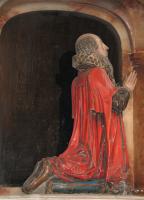
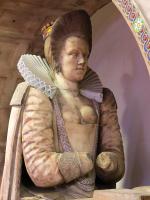
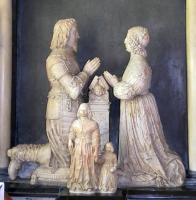
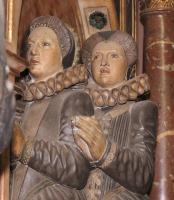
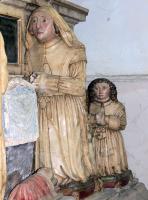
Kneeler monuments are one of the most characteristic types of sculptural monument in British churches, featuring profile figures of bearded men – knights or merchants and grand dames, generally wearing ruffs, kneeling and praying, often under grand canopies, and typically painted in bright colours. They are sometimes familiarly called ‘Tudor monuments’, but generally date from after the time of Queen Elizabeth, the last Tudor monarch, so are more usually Stuart monuments. Many grand churches and Cathedrals have one or two such kneeler monuments.
Our typical statue of a kneeler is a straight-backed figure, in perfect profile to the viewer directly in front of the monument, who kneels on a tasselled cushion and has their hands raised in prayer, pointing at a comfortable angle forwards and upwards. More often than not, in front of the figure will be a prayer desk. If there are a pair of figures, man and wife, they will generally kneel facing each other across the prayer desk, or two prayer desks, and if they have children, these will often be shown in miniature, under them or behind them, the boys with their father, the girls with their mother. The principal figure or figures will generally be under or slightly in front of a round arch supported on pillars, or each of a pair may have their own arch or niche with a pendant centre going behind the central prayer desk. Above is generally a canopy, or shelf, with maybe a coat of arms at the very top. Underneath, our kneelers are generally set on some solid structure with a broad shelf, heavy supports, sometimes a great sideboard of a structure reaching down to the floor. An example of an archetypical kneeler monument, with two kneelers, is below: it is to Edward and Dorothye Holte, in Aston Parish Church, Birmingham.
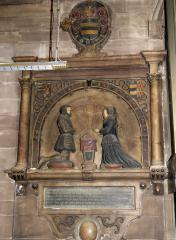 Classic kneeler monument of the end of the 16th Century.
Classic kneeler monument of the end of the 16th Century.
Let us look at the kneeler statues themselves. The men come in two types: merchants and knights. The merchants wear robes, usually voluminous flowing robes which completely conceal the figure, and the bent legs and feet as well, though the folds in the drapery give some minimal indication of the position of the knees. Where the figures are painted, which is usual, then these robes are black, or occasionally dark red – while generally repainted from time to time, there is little reason to think that the restorers vary from the original colour scheme. Sometimes there is an outer cape, open at the front or with armhoes, and then we generally see a buttoned tunic underneath, and a belt, quite broad, and then some loose lower garment which tends to merge with the outer robe. There may be finely carved fur lining to the cape. Above, there is almost invariably a thick, generous ruff, which may be painted white, and this looks uneasy to modern eyes as it rather detaches the head visually from the body. In our other type of male figure, we have a knight, who will be shown in plate armour, more usually complete, or sometimes with pantaloons exposed, under an apron of plate. With plate armour, there is opportunity to show the lines of the figure, so on our knights we generally see the shape of the waist, the thigh, the calves, which seem to have been much admired. There may be a visible knife or sword Gauntlets are not worn, as our knights are in prayer, nor do they wear helmets, nor are either gauntlets or helmets seen next to the figure. Even the knights will generally have ruffs, and there may be smaller ruffs at the cuff above the wrist too. Whether an armoured knight or a merchant, a beard is a necessity.
Typical male (armoured knight) and female kneelers. 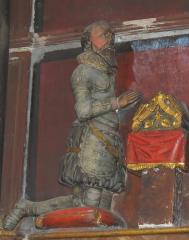
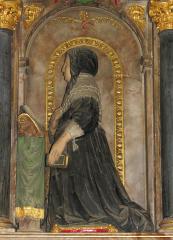
And how about the women – the grand dames and ladies? A vast shapeless mass of drapery is the norm, or in some monuments, stays – a cage within the skirts to bulk them out in the most unattractive way. While the men may be young or middle aged, the style for women, in the main, is to show them old and ugly, not in every case, but in the majority. It may be because often they outlived their husbands, and thus it seemed appropriate to show them older. And perhaps the extreme plumpness and broadness of face was considered a mark of wealth. But still, there are an awful lot of carved harridans out there. So, long black skirts that make the figure as dumpy as possible, again no sign of feet, the arms puffed up with drapery and with ruffs at the cuff, so even a hint of an elegant, feminine wrist is avoided. The hair is sometimes exposed, but generally there is at least some form of headpiece, sometimes of great richness, others a strange hat or a simple shawl: it is the giant ruff about the neck which is the main sign of wealth. Occasionally we do see a younger woman, and the figure of Lady Lucy Percy Stanley in Walthamstow Church is one such, her fan-like ruff spread open so we can see her unlined neck, her round breasts exposed above her bodice. That monument has been ascribed to William Cure the Younger, and in Cranford Church, south of central London and north of Heathrow, the Sir Roger Aston monument, more certainly given to that sculptor, has disturbingly busty female figures, painted rather too brightly.
I should mention the painting – extra coats of opaque red and black and a bit of gilt are easy enough, but flesh tones are more difficult, and much of the delicacy of carving can be lost by too enthusiastic retouching. Many of the kneeler figures have rather a naďve or even banal look because of the face painting, and the comparison with the hands, which are less painted, or alabaster figures with no painting at all, suggests that the sculptor has not been done justice by later daubers.
To save their knees, almost all kneeler figures rest on cushions, generally painted red, with gold tassels at the corners; subsidiary figures may have other colours to their cushions.
Ranked offspring, separated by custom into boys and girls. 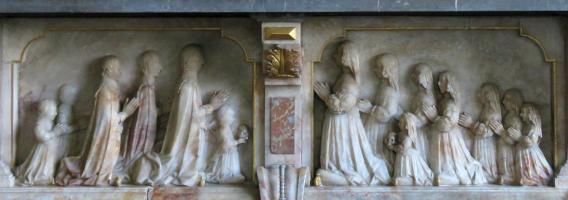
The offspring of the deceased, who may be grown up, are ranked in rows of identical kneeling figures, as like as possible to their parents, the boys under the father, the girls under their mother. They are much smaller than their parents. If the father is a knight, then only the first son can follow him and will wear armour; his younger brothers will be in the usual black robes, but otherwise they will be identical. By convention, those offspring who had died by the time the monument was put up either hold a skull, as in the example above, or have one tucked under the corner of their tasselled cushion. Some variations are below. To the left, Sir Thomas Offley, in the City Church of St Andrew Undershaft, with the offspring between their parents, which is unusual; Gregory Lovell, in St Mary, Merton, very unusually with the children grouped in mixed sexes, as the grouping is rather by the two different mothers. And Richard Staper, in another City Church, St Helen's Bishopsgate, as an example with the girls behind the mother, the boys behind the father; the former all sharing the rather odd style of headpiece of their mother.
Variations on kneeling children: Offley, Lovell, Staper (see text above). 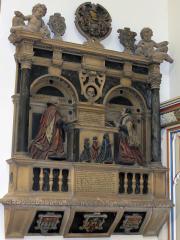
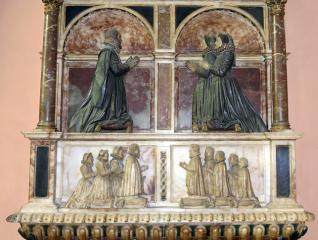
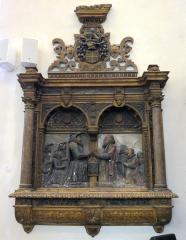
Now to the surrounding architecture. As mentioned, our kneeler statues rest under canopies, and these are Classical – thus with pillars or flattened pillars (pilasters) to the sides, and either a flat shelf on top, perhaps with a space below which could incorporate narrow panels (entablature) - see for example the Layer monument, below centre, in St John Maddermarket, Norwich, or a round headed arch or arches. If we have two arches, one for each of a pair of figures, then the central ‘pillar’ supporting both arches will normally descend behind the prayer stool, or be a pendant above it - examples of both types are shown above.
At the very top, above the upper shelf, there will normally be a coat of arms, often in a roundel or cartouche, and perhaps a pediment or curved pediment.
Below the kneeling figures is normally some heavy, blocky structure: on the largest kneeler monuments this would be a sideboard like affair resting on the ground, but normally it is the lowest part of the monument, and may contain the inscription on a black panel. Then there might be a receding part to the wall, with ornamental brackets, or an apron – that is to say, a flat portion of the monument below the lowest shelf, which may be curved or rectangular, bearing carved ornament.
Architectural surrounds: colossal Spencer monument, multi-layered Raynton monument, Layer monument with niches, Parkes - Classical with a Gothic tinge, and Capponi's portico. 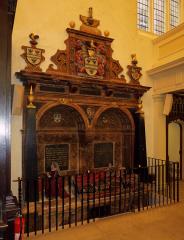
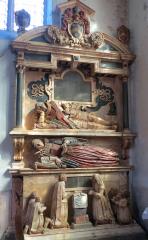
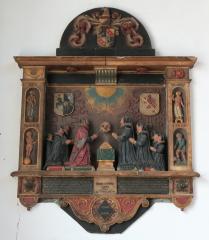
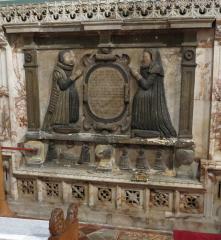
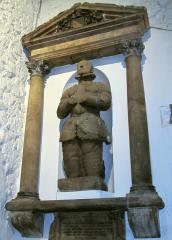
Now all this architectural surround gives flat surfaces for sculptural decoration: there is the back portion behind the figures within the niche or canopy; the flat surfaces to the pilasters, the roughly triangular spaces (called spandrels) over the arches, and the base and apron. Strapwork is not uncommon – so named as it looks like a series of straps or belts, equal width and depth, used as a space-filling device, and especially in surrounding the coat of arms at the top of many such kneeler monuments. Strapwork is a hearkening back to earlier monuments of the first part of the 16th Century, great panels where strapwork was often the dominant decorative feature - you can see several examples on this page, if you click to enlarge the pictures, and particularly nice ones are the Spencer monument in St Helen's Bishopsgate, above left, and the Staper monument further up, right.
Also in high relief on the flat portions of the monument, especially the pilasters, are found memento mori – those macabre little designs to remind the viewer that they too shall die. Skulls with crossbones (lots of examples on this page), gravediggers’ tools, and emblems of time such as scythes and hourglasses.
The example second from left above, which is the Nicholas Raynton monument in Enfield Church, combines recumbent figures with kneelers, in this case with a multi-layered approach; or there can be a figure on top of an altar tomb with kneelers on the sides, as in the example second from right above, where the upper figure is not shown: this is the Richard Parkes monument in St Bartholomew, Wednesbury. The reconstructed monument to Peter Capponi in St Olave Hart Street, above far right, survives only in part, but I chose it as it shows the structural surround in the form of a Classical portico most clearly, and in being a rare example of a forward-facing kneeler (if indeed the statue was actually mounted that way originally).
We have not said much about the dates of kneeler monuments. Although there are some number from Queen Elizabeth I’s time (1558-1603), thus Tudor, they are mostly the time of James I of England (James VI of Scotland), who ruled from 1603-25, with some from Charles I’s reign, 1625-1649. It is difficult to know just when some of these monuments were put up anyway, as some were erected only some years after the death of the person commemorated. The monument to Sir John Garrard in Wheathamstead, Hertfordshire, has been described as ‘1677 or earlier’, and if it is 1677, this would be a generation later than normal for such monuments.
Finally, we must note that with monuments of this age particularly, it may be that during repairs or reconstruction, or salvage of some remnant of an original piece, we may end up with something rather different from that intended by the original sculptor. Below is the statue of poor Katherine Elyott, in St Mary's Church, Reigate, where not only has the surviving figure been placed under a Gothic arch, but her little stool has been jammed in horizontally rather than upright, with her prayer book on top. Such are the tribulations of our kneeler monuments over four centuries.
Elyott monument, not as intended. 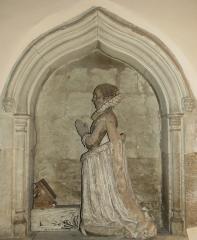
Visits to this page from 1 January 2018: 6,283
Carved skulls in monuments // Cherubs // Winged Cherub Heads // Obelisk monuments
Introduction to church monuments // Churchyard and cemetery monuments
Churches in London // Other places (some with churches described)